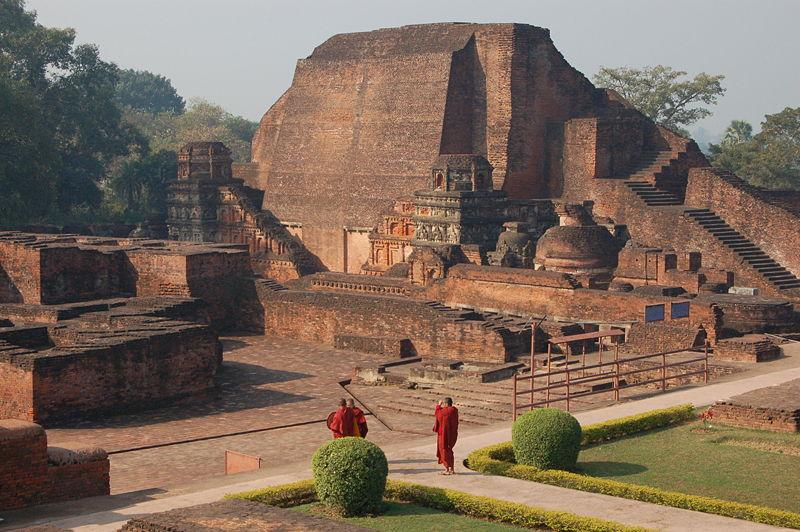Important Facts For Prelims
Inauguration of Nalanda University
- 22 Jun 2024
- 6 min read
Why in News?
Recently, the campus of Nalanda University was formally inaugurated by the Prime Minister of India.
- It is spread across 455 acres, located in Rajgir, Bihar. The site is only 12 km away from the ruins of the ancient Buddhist monastery of the same name.
What is the History and Revival Efforts of Nalanda University?
- History:
- Gupta Emperor Kumaragupta (Shakraditya) of the Gupta dynasty founded Nalanda University in 427 CE in modern Bihar in the early 5th century, and it flourished for 600 years until the 12th century.
- During the era of Harshavardhana and the Palas monarchs, it rose to popularity.
- During King Harshavardhana's reign (606-647 AD) Chinese scholar Xuan Zang (also known as Hiuen Tsang and Moksadeva, a 7th-century Chinese Buddhist monk, scholar, traveller, and translator) came here and studied for about 5 years.
- He also carried back many scriptures from Nalanda, which were later translated into Chinese.
- In 670 AD, another Chinese pilgrim I-Tsing visited Nalanda. He stated that Nalanda housed 2,000 students and was supported by money from 200 villages.
- A large number of students have come to study from China, Mongolia, Tibet, Korea, and other Asian countries.
- Archaeological evidence also indicates contact with the Indonesian Shailendra dynasty, one of whose kings built a monastery in the complex.
- Spiritual divines like Lord Buddha and Lord Mahavira meditated in this region, adding to the positive vibrancy of the area.
- Great masters such as Nagarjuna, Aryabhatta, and Dharmakirti contributed to the scholarly traditions of ancient Nalanda.
- The university was destroyed in 1193 by Bakhtiyar Khilji, a general of the Turkish ruler Qutbuddin Aibak.
- It was rediscovered in 1812 by Scottish surveyor Francis Buchanan-Hamilton and later identified as the ancient university by Sir Alexander Cunningham in 1861.
- Attacks:
- The first attack on Nalanda Mahavihara occurred between 455-470 AD during the reign of Emperor Samudragupta of the Gupta Empire.
- The attackers were the Hunas, a Central Asian tribal group, primarily motivated by the desire to loot the university's valuable resources.
- Emperor Skanda Gupta later re-established the university. It was during his reign that the renowned Nalanda library was founded.
- The second attack on Nalanda Mahavihara occurred in the early 7th century, planned by Goudas emperors of Bengal.
- The attack was driven by political tensions with Emperor Harshavardhana of Kannauj.
- Despite destruction, the university was restored by Harshavardhana, allowing Nalanda to continue its mission of global knowledge dissemination.
- The first attack on Nalanda Mahavihara occurred between 455-470 AD during the reign of Emperor Samudragupta of the Gupta Empire.
- Revival:
- The idea for revival emerged in the early 2000s. Former President A.P.J. Abdul Kalam, the Singapore government, and leaders of East Asian Summit (EAS) countries all advocated for Nalanda's return.
- The Indian Parliament passed the Nalanda University Act in 2010, providing a legal framework for the new institution.
- Nalanda University is envisioned as a collaborative effort between India and other East Asian nations, symbolising a renewed focus on regional knowledge exchange.
- The Bihar government provided a 455-acre site near the ancient ruins. The architect, B.V. Doshi, designed an eco-friendly campus reflecting the spirit of the past while incorporating modern amenities.
- The university offers postgraduate programs in various fields, including Buddhist Studies, Historical Studies, Ecology and Environmental Studies, and International Relations.
- The Campus is a ‘Net Zero’ Green Campus. It is self-sustainable with a solar plant, domestic and drinking water treatment plant, water recycling plant for reusing wastewater, 100 acres of water bodies, and many other environment friendly facilities.
- The ruins of Nalanda Univesity was declared as a UN Heritage Site in 2016.
East Asia Summit:
- The EAS was established in 2005 as an Association of Southeast Asian Nations (ASEAN)-led initiative.
- It is the only leader-led forum in the Indo-Pacific that brings together all key partners to discuss political, security and economic issues of strategic importance.
- It operates on the principles of openness, inclusiveness, respect for international law, ASEAN centrality, and ASEAN’s role as the driving force.
UNESCO’s Heritage Sites Related to Buddhism:
- Archaeological Site of Nalanda Mahavihara at Nalanda, Bihar
- Buddhist Monuments at Sanchi, MP
- Mahabodhi Temple Complex at Bodh Gaya, Bihar
- Ajanta Caves Aurangabad, Maharashtra.
- The Buddhist chanting of Ladakh was included in UNESCO’s Representative List of Humanity's Intangible Cultural Heritage in 2012.





